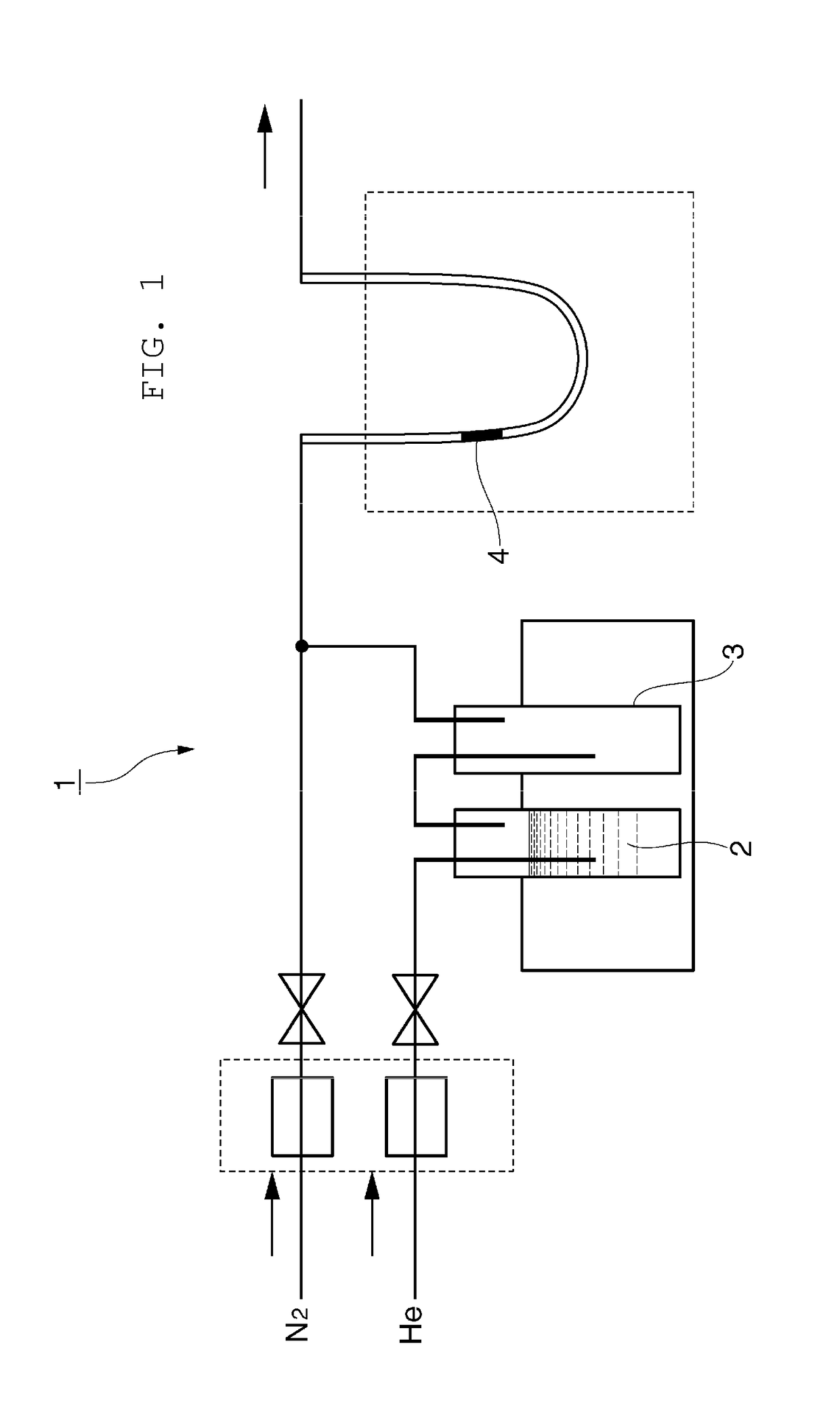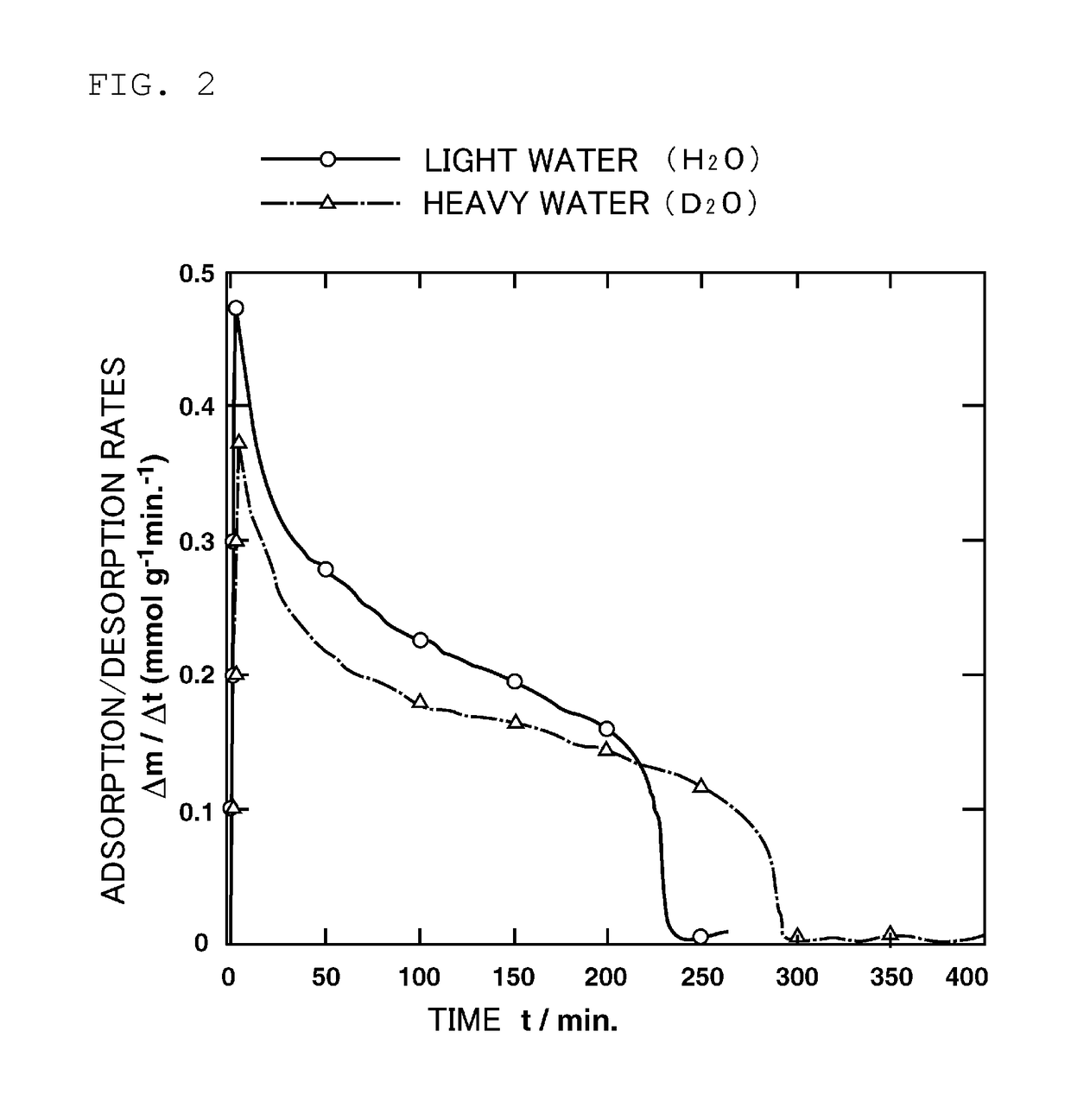Method for producing deuterium depleted water, method for separating heavy water and light water, and method for producing deuterium concentrated water
a technology of deuterium depletion and concentrated water, which is applied in the direction of water, heavy water, separation processes, etc., can solve the problems of pure heavy water annihilating living organisms, malfunctioning biological reactions, and different heavy water and semi-heavy water, so as to reduce the relative pressure of water vapor, reduce the concentration of deuterium, and produce deuterium depletion easily and in a short time.
- Summary
- Abstract
- Description
- Claims
- Application Information
AI Technical Summary
Benefits of technology
Problems solved by technology
Method used
Image
Examples
first embodiment
[0073]In a first embodiment, utilizing the first 10 minutes with a high desorption rate, deuterium depleted water is obtained.
[0074]An adsorbent containing activated carbon (not illustrated) is disposed in an adsorption tower 5, illustrated in FIG. 4, used in the first embodiment. The adsorption tower 5 is formed with an inlet 6 for water vapor and dry air; a vent port 7 for deuterium depleted water; and a recovery port 8. The inlet 6, vent port 7, and recovery port 8 are provided with valves V1, V2, and V3, respectively.
[0075]In the first embodiment, first, the valve V1 and the valve V2 are opened with the valve V3 kept closed, and water vapor is allowed to flow from the inlet 6 to the adsorption tower 5 so that the adsorbent 4 adsorbs the water vapor until reaching saturation.
[0076]Next, water vapor is desorbed from the adsorbent 4.
[0077]In order to desorb water vapor from the adsorbent 4, a relative pressure (adsorption equilibrium pressure / saturation water vapor pressure) of wat...
second embodiment
[0084]In a second embodiment, seeing the processes in the first embodiment as one cycle, the cycle is repeated more than once.
[0085]First, the processes in the first embodiment are carried out so as to recover water vapor from the recovery port 8, and to eliminate water vapor remaining in the adsorption tower 5 from the vent port 7 (the first cycle).
[0086]Next, the recovered water vapor is reintroduced from the inlet 6, and the adsorbent is allowed to adsorb the water vapor until reaching saturation. Then, dry air is supplied for 10 minutes to recover the water vapor from the recovery port 8. Thereafter, water vapor remaining in the adsorption tower 5 is eliminated from the vent port 7 (the second cycle).
[0087]These processes are repeated until the fifth cycle.
[0088]The left column of FIG. 5 illustrates a deuterium concentration in each cycle of water vapor to be recovered from the recovery port 8, and a quantity in each cycle of water vapor to be recovered per 1 gram of water vapor...
third embodiment
[0092]In a third embodiment, used is a device in which five adsorption towers each containing an adsorbent are connected in series.
[0093]In this device, five adsorption towers from a first tower 11 to a fifth tower 15 are connected in series with connecting pipes as illustrated in FIG. 6.
[0094]The first tower 11 is formed with an inlet 16, and a vent port 17. The fifth tower 15 is formed with a recovery port 18.
[0095]The inlet 16, the vent port 17, the connecting pipes connecting the adsorption towers, and the recovery port 18 are provided with valves V4, V5, V6, V7, V8, V9, and V10.
[0096]If required, each adsorption tower maybe provided with an inlet, and a vent port.
[0097]In this device, in advance, an adsorbent of the first tower 11 is allowed to adsorb water vapor having a deuterium concentration of 150 ppm, an adsorbent of the second tower 12 is allowed to adsorb water vapor having a deuterium concentration of 135 ppm, an adsorbent of the third tower 13 is allowed to adsorb wat...
PUM
| Property | Measurement | Unit |
|---|---|---|
| humidity | aaaaa | aaaaa |
| humidity | aaaaa | aaaaa |
| humidity | aaaaa | aaaaa |
Abstract
Description
Claims
Application Information
 Login to View More
Login to View More - R&D
- Intellectual Property
- Life Sciences
- Materials
- Tech Scout
- Unparalleled Data Quality
- Higher Quality Content
- 60% Fewer Hallucinations
Browse by: Latest US Patents, China's latest patents, Technical Efficacy Thesaurus, Application Domain, Technology Topic, Popular Technical Reports.
© 2025 PatSnap. All rights reserved.Legal|Privacy policy|Modern Slavery Act Transparency Statement|Sitemap|About US| Contact US: help@patsnap.com



